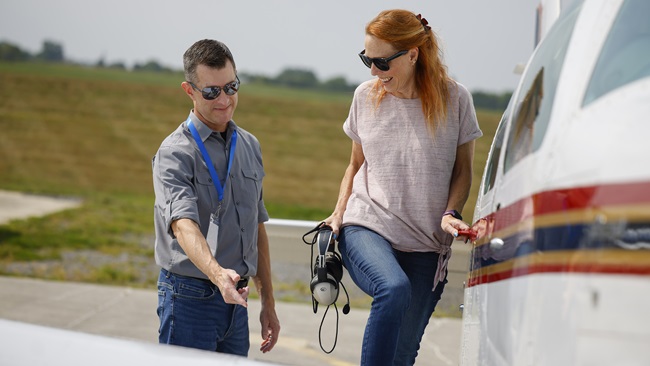Basics always apply
Success in multiengine training depends upon a strong foundation
By John W. Olcott
Learning to fly multiengine aircraft requires a focus on the basics and mastering their personalities.

Although there are physical differences between a primary trainer and a sophisticated light twin, basic concepts of training apply to mastering both aircraft. First among those basics is planning—knowing what to do before attempting the desired action.
Think of a twin as an aircraft with two personalities—one when both engines are operating, and a second personality when one engine is inoperative. In the former case, a twin behaves like a high-performance single. That’s the good news. In addition to being a good performer, a twin provides the peace of mind that comes from engine and system redundancy—all good features when flying at night, on instruments, or over hostile terrain. Benefiting from a twin’s capabilities, however, requires knowing how to deal with its personality when only one engine is operating.
Know the basics
Engine redundancy is comforting, but the basics still apply. Hence, the self-discipline a student develops during ab initio training applies to more advanced areas of flight such as becoming certificated for flying twins. The student must know the aircraft, develop the hand-eye coordination needed for control, and make good decisions among the available options. While the pilot of a twin has more options, the piloting process is an extension of his or her primary training. Furthermore, testing for a multi rating includes the basics, starting with normal twin-engine operations and proceeding into single-engine procedures. Success for all advanced certification is built upon a foundation of basics.
Pilots seeking multiengine certification must know a light twin’s capabilities and limitations. Consider the following: By virtue of having two engines, a twin has twice the chance of experiencing an engine failure on each flight. However, a twin has many more options than a single when an engine fails. The applicant for multiengine authorization must know and demonstrate engine-out options; having two engines offers value only if the pilot knows what to do when a failure occurs.
When starting twin training, consider the big picture—those concepts that apply to all aircraft. Fundamentals are needed to operate all aircraft safely and efficiently. An excellent approach is captured in the memory jogger PAVE, which stands for Pilot, Aircraft, enVironment and External factors. Memory joggers such as ARROW (Airworthiness certificate, Registration, Radio station license for international operations, Operating limitations, and Weight & balance) for required documentation and AAV1ATE (Annual inspection, Airworthiness directives, VOR checks, 100-hour inspection if used for hire, Altimeter and static system tests, Transponder tests and Emergency locator transmitter checks) for required inspections still apply. Applicants for a multi ratings will be queried on those and other fundamentals. Like checking out in any unfamiliar aircraft, the multiengine student is expected to be proficient in basic air work and airport techniques. The FAA’s airman certification standards provide the roadmap to be navigated—when both engines behave and when one fails.
The light twin’s other personality dominates when an engine fails. What had been a great performer with both engines operating becomes a grossly underpowered dog.
With one engine inoperative (OEI) a twin’s performance is decreased by about 80 percent, not by half as might be assumed when 50 percent of available power is lost. Consider a Beech Baron B58, which has approximately 1,600 feet per minute rate of climb with both engines operating at maximum gross weight under standard atmospheric conditions. With one engine inoperative, however, rate of climb drops to about 400 fpm—but only if the inoperative engine has been properly shut down, its propeller feathered, the aircraft re-trimmed to compensate for the asymmetric thrust that occurs when an engine fails, and the aircraft flown at the proper airspeed.
Like all underpowered aircraft, there is no margin for error or sloppiness when an engine fails in a light twin. That’s the bad news. The good news is that the aircraft will remain aloft provided the pilot follows procedures recommended in the pilot’s operating handbook. Furthermore, an aircraft’s performance deteriorates relatively quickly when an engine fails, but the loss is not instantaneous. There is sufficient time for the pilot to follow standard operating procedures and achieve safe flight with one engine inoperative.
Hence the need for planning—playing the “what if” game. What if the engine fails during takeoff? What if the engine fails during cruise or any other phase of flight? A pilot needs to plan. He or she must know what to do before being required to act. That’s what planning is all about, whether flying a single or a twin. Planning is basic.
John W. Olcott is an airline transport pilot, CFII, and remote pilot.


